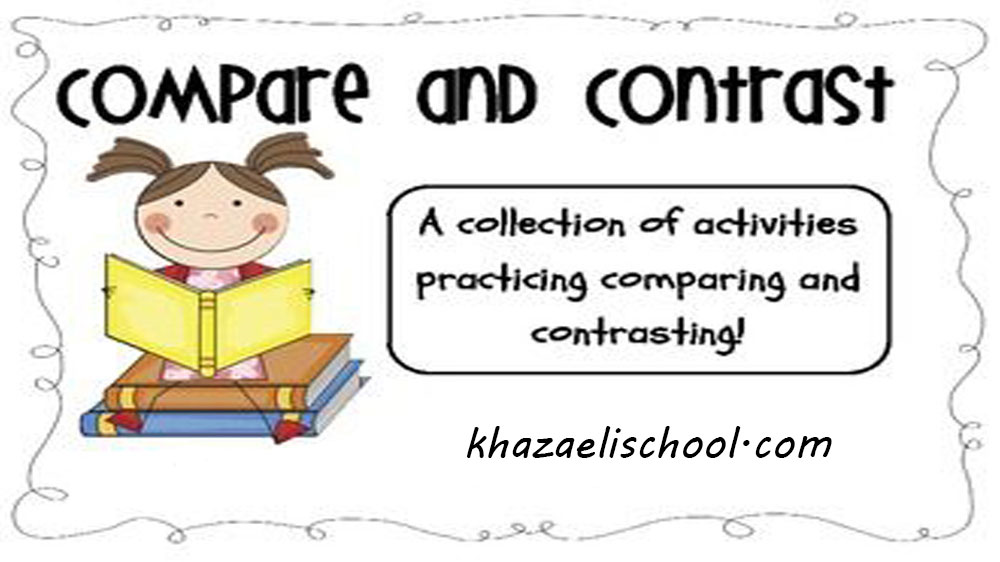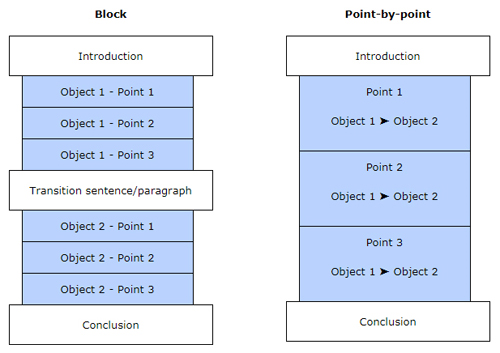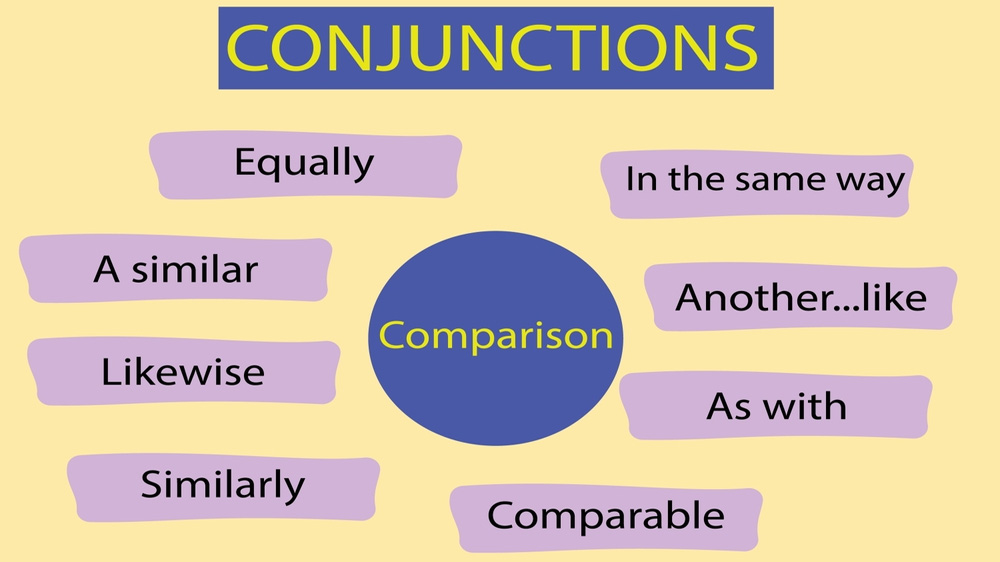مغایرت و مقایسه انگلیسی Compare & Contrast Essays در جمله یکی از رایجترین انواع نوشتار دانشگاهی است. نوشتار دانشگاهی به عنوان یک مقاله یا به عنوان بخشی از یک مقاله بزرگتر که شامل یک یا چند پاراگراف مقایسه و مغایرت انگلیسی است, شناخته میشود. در این صفحه اطلاعاتی در این زمینه به شما داده میشود که یک مقاله از نوع مقایسه و مغایرت انگلیسی چیست و چگونه باید آن را تنظیم کرد. چگونه باید کلمات مربوط به این مقالات را به کار برد و چگونه باید اطمینان حاصل کرد که از معیارهای مناسبی برای این نوع مقالات استفاده کردهایم.
مثالی از مقاله مقایسه و مغایرت در رشته تکنولوژی ارتباطات هم در اینجا آورده شده است تا بتوانید در این حوزه تمرین داشته باشید. همچنین, میتوانید مطالب بیشتر در مورد بهترین آموزشگاه زبان را اینجا مطالعه کنید.

مغایرت و مقایسه انگلیسی جمله
مقایسه به معنای این است که ببینیم چگونه چیزها به هم شباهت دارند, اما مغایرت به این معناست که دریابیم چیزها چگونه با هم تفاوت دارند. بنابراین مقالهی مقایسه و مغایرت به بررسی شباهتها و تفاوتهای دو یا چند چیز میپردازد.
این نوع مقاله در دانشگاه رایج است، جایی که مدرسان بارها و بارها میزان یادگیری و فهم شما را با سؤالهایی از این دست به چالش می کشند. مغایرت و مقایسه انگلیسی دو نظریه، دو روش، دو دوره تاریخی یا دو شخصیت یک داستان و یا موارد دیگر را مورد مقایسه و مغایرت قرار دهید. بعضی اوقات کل مقاله، مقاله مقایسه و مغایرت است و بعضی اوقات ممکن است فقط بخشی از یک مقاله باشد. در برخی مقالات خصوصاً مقالات کوتاه، ممکن است فقط به شباهتها یا تفاوتها پرداخته شود و به هردوی آنها پرداخته نشود. به مثالهایی که در ذیل آمده است توجه کنید:
• نظریههای نیوتن درباره جاذبه را با نظریات انیشتین در این مورد مقایسه کنید و شباهتها و تفاوتهای آنها را بیان کنید. (مقالهی مقایسه و مغایرت)
• شباهتهای میان اقتصاد اسپانیا و چین را مورد بررسی قرار دهید. (مقالهی مقایسه)
• تفاوتهای میان امپراتوری اسپانیا و امپراتوری چین را شرح دهید. (مقالهی مغایرت)
ساختار جمله در زبان انگلیسی (Structure)
دو روش اصلی برای تنظیم ساختار جمله در زبان انگلیسی در یک مقاله مقایسه و مغایرت وجود دارد. این دو روش مغایرت و مقایسه شامل استفاده از ساختار نقطه به نقطه(point-by-point) یا بلوک(block) می شود. ساختار بلوکی، شامل تمام اطلاعات درباره یکی از موضوعات مورد مقایسه یا مورد مغایرت میشود. سپس, کلیهی اطلاعات درباره یک موضوع دیگر فهرست میشود.
این نوع ساختار مغایرت و مقایسه انگلیسی, شبیه به ساختار بلوکی است که برای مقالات علت و معلولی (cause and effect) و مقالات حل مسئله (problem-solution) استفاده میشود. برای ساختار نقطه به نقطه(point-by-point)هر شباهت (یا تفاوتی) برای یک چیز بلافاصله به دنبال شباهت (یا تفاوت) دیگری میآید. هردو نوع ساختار جمله در زبان انگلیسی (نقطه به نقطه و بلوک) محاسن خود را دارند. اولی برای نوشتن سادهتر است, درحالیکه دومی به طور کلی واضحتر است. ساختار بلوکی مقالات انگلیسی, شباهتها یا تفاوتهای صریحتر را تضمین میکند. این دو نوع ساختار در جدول زیر نمایش داده شده است:

برای مطالعه بیشتر در مورد مقالات مغایرت و مقایسه انگلیسی حتما بخوانید: مقالات مباحثه ای
کلمات مربوط به ساختار مقایسه و مغایرت
این کلمات علائم انتقالی هستند که شباهتها یا تفاوتها را نشان میدهند. در ذیل تعدادی از مثالهای رایج مغایرت و مقایسه انگلیسی جمله را آوردهایم:
Compare
• Similarly
• Likewise
• also
• both... and...
• not only... but also...
• neither... nor...
• just like (+ noun)
• similar to (+ noun)
• to be similar (to)
• to be the same as
• to be alike
• to compare (to/with)
Examples
• Computers can be used to communicate easily, for example via email. Similarly/Likewise, the mobile phone is a convenient tool for communication.
• Both computers and mobile phones can be used to communicate easily with other people.
• Just like the computer, the mobile phone can be used to communicate easily with other people.
• The computer is similar to the mobile phone in the way it can be used for easy communication.
Contrast
• However
• In contrast
• In comparison
• By comparison
• On the other hand
• while
• whereas
• but
• to differ from
• to be different (from)
• to be dissimilar to
• to be unlike
Examples
• Computers, although increasingly small, are not always easy to carry from one place to another. However, the mobile phone can be carried with ease.
• Computers are generally not very portable, whereas the mobile phone is.
• Computers differ from mobile phones in their lack of portability.
• Computers are unlike mobile phones in their lack of portability.
معیارهای مقایسه و مغایرت جملات
وقتی مقایسهای را انجام میدهید, مهم است که مشخص کنید از چه معیارهایی استفاده میکنید. مثال زیر را که دو نوع از افراد را باهم مقایسه میکند، مطالعه کنید. در اینجا معیار برای مقایسه مشخص نیست.
• آرون بلند و قوی است. در مقایسه بروس خوش تیپ و خیلی باهوش است.
با آنکه این جمله علامت انتقال دارد, اما معیارهای مقایسه در آن یکسان نیست. معیاری که برای آرون به کار رفته است قد (بلند) و قدرت (قوی) است. ما انتظار داریم که همین معیارها برای بروس هم به کار رود (مثلاً کوتاه و ضعیف باشد). با این حال، معیارهای جدیدی از جمله معیار ظاهر (خوش تیپی) و ذکاوت (باهوش) را داریم.
اینها نمونههایی از اشتباهاتی است که هنگام نوشتن این نوع پاراگرافها یا مقالات از دانشجویان، سر میزند. در مثال زیر, معیارهای واضحتری برای مغایرت و مقایسه انگلیسی جمله مورد استفاده قرار گرفته است.
آرون و بروس در چهار چیز با هم اختلاف دارند. تفاوت اول در قد آنهاست, آرون قد بلند است درحالیکه بروس کوتاه قد است.
تفاوت دوم در قدرت است. آرون قوی است و در مقایسه با او، بروس ضعیف است. تفاوت سوم در ظاهر آنهاست که آرون ظاهری متوسط دارد و با بروس که خوش تیپ است، متفاوت است. آخرین تفاوت در ذکاوت آنهاست که آرون از لحاظ هوش متوسط است و از طرفی، بروس خیلی باهوش است.
نمونه مقاله
در این مقاله از ساختار نقطه به نقطه برای مغایرت و مقایسه انگلیسی جمله استفاده شده است. بر روی قسمتهای مختلف در سمت راست میتوانید کلیک کنید (در قسمتهای سایهدار سمت راست) تا جنبههای ساختاری متفاوت این مقاله را ببینید مثل شباهتها، تفاوتها و کلمات ساختاری. در اینجا نه تنها پاراگرافها بلکه شرح تز و خلاصه پایان نامه هم نشان داده میشود و مقایسه و مغایرت موجود در بخش اصلی متن را تکرار میکند. مقالات بیشتر را با دنبال کردن صفحه رسمی لینکدین ما مطالعه کنید.
فهرست بررسی
در ذیل فهرست بررسی برای مقالات مقایسه و مغایرت انگلیسی جملات آورده شده است. فهرست را برای بررسی نوشتههای خود استفاده کنید یا از هم کلاسی خود بخواهید تا در بررسی مقالات مغایرت و مقایسه انگلیسی به شما کمک کند.
| مورد |
درست است؟ |
پیشنهاد |
| مقاله یک مقاله مقایسه و مغایرت است |
|
|
| از ساختار مناسبی استفاده شده، ساختار بلوکی و یا ساختار نقطه به نقطه |
|
|
| از کلمات مقایسه و مغایرت به درستی استفاده شده است |
|
|
| معیار مقایسه و مغایرت واضح و روشن است |
|
|
| مقاله دارای شرح تز روشنی است |
|
|
| هر پاراگراف، جمله موضوعی روشنی دارد |
|
|
| مقاله از پشتیبانی خوبی برخوردار است (حقایق، دلایل، مثالها و غیره) |
|
|
| نتیجه گیری شامل خلاصهای از مهمترین موارد است |
|
|
مقایسه Comparison

عبارات بیان کننده مقایسه و قصد و هدف
نویسنده: American-English File
مترجم: رؤیا کریمی جنابی
clauses of contrast
1. Although the ad said it would last for years, mine broke after two months.
I went to work even though she sometimes annoys me.
I like Ann, though she sometimes annoys me.
2. In spite of (Despite)
her age, she is still very active.
being 85, she is still very active.
the fact that she’s 85, she is still very active.
برای مقایسه کردن از این کلمات استفاده کنید:
Although, though, even though, and in spite of or despite.
1. although, even though را همراه با یک عبارت به کار برید. although و even though را هم میتوانید در ابتدای جمله و هم در وسط جمله بیاورید.
• even though از although جدیتر و قویتر است و برای بیان مقایسههای بزرگ و متعجب کننده استفاده میشود.
• though از although غیر رسمیتر است و فقط در وسط جمله قرار میگیرد.
2. بعد از spite of یا despite از یک اسم، یک فعل استمراری یا ساختار the fact that+ subject+ verb استفاده کنید.
• به یاد داشته باشید که پس از despite از of استفاده نکنید:
NOT despite of the rain…
عبارات بیان کننده قصد و هدف از انجام کار
clauses of purpose
1. I went to the bank to/ in order to/ so as to talk to the bank manager.
2. I went to the bank for a meeting with the bank manager.
3. I went to the bank so that I could talk to the manager in person.
4. I wrote down what he said so as not to forget it.
برای بیان قصد و هدف انجام کار از ,so as to, for, and so that in order to, to استفاده میکنیم.
1. بعد از to, in order to, and so as to شکل اصلی فعل را به کار میبریم.
2. for را همراه با یک اسم به کار برید مثل for a meeting. برای توضیح درباره علت دقیق انجام یک کار میتوانیم for را همراه با اسم مصدر هم به کار بریم:
This liquid is for cleaning metal.
3. بعد از so that فاعل به اضافه یک فعل وجهی (.can, could, would, etc) قرار میگیرد.
4. برای بیان قصد و هدف به صورت منفی از so as not to or in order not to استفاده میکنیم:
I wrote down what he said in order not to forget it. NOT to not forget it.
ترجمه شده از 4 American-English File Student Book
مقایسه
modifiers with as…as…
My sister's almost as tall as me/ almost as tall as I am.
She's just as bossy now as when she was a child.
Their house is nearly as big as yours.
His latest movie isn't half as good as his previous one.
Our new apartment is twice as big as our old one.
The vacation cost three times as much as I'd expected.
اغلب از معرفهایی (modifiers) مثل .almost, just, and nearly, and half, twice, three times, etc همراه با as…as استفاده میکنیم.
• بعد از as…as هم میتوان از یک ضمیر فاعلی به اضافه فعل کمکی استفاده کرد و هم میتوان از ضمیر مفعولی استفاده کرد:
She drives as fast as I do OR she drives as fast as me.
twice را فقط میتوان قبل از as…as قرارداد:
NOT our new apartment is twice bigger than our old one.
درحالی که .three times, four times, etc را میتوان هم با as…as وهم با یک قید یا صفت تفضیلی به کار برد:
The vacation cost three times more than I'd expected.
modifiers with comparative adjectives or adverbs
1. The play was much better than I'd expected.
He's driving a lot more carefully since he got points on his license.
The Hawaiian coffee is far more expensive than the Colombian one.
2. She earns much more money than I do.
Women today have many more opportunities than they used to.
3. She's a little better than she was yesterday.
The later train is slightly cheaper than the earlier one.
Could you two talk a bit more quietly, please? I'm trying to concentrate.
4. A: Would you like some more coffee?
B: just a little more, please.
We only have a few more minutes before the show starts.
5. The taxi driver drove faster and faster.
It's getting more and more difficult to make ends meet nowadays.
1. برای نشان دادن تفاوت زیاد از much, a lot, far به اضافه قید یا صفت تفضیلی استفاده میکنیم.
2. وقتی برای بیان تفاوتهای بزرگ از ساختار more+ noun استفاده میکنیم، much/ far/ a lot more را با اسامی غیرقابل شمارش و many/ far/ a lot more را با اسامی جمع قابل شمارش به کار میبریم.
3. برای بیان تفاوتهای کوچک از slightly یا a little همراه با قید یا صفت تفضیلی استفاده میکنیم.
4. وقتی برای بیان تفاوتهای کوچک از ساختار more+ noun استفاده میکنیم، a little/ slightly/ a little bit more را با اسامی غیرقابل شمارش و a few/ slightly را برای اسامی جمع قابل شمارش به کار میبریم.
5. بعضی اوقات برای تأکید بیشتر یک قید یا صفت تفضیلی را دو بار تکرار میکنیم. وقتی میخواهیم مقایسه را با more انجام دهیم، قید یا صفت فقط بعد از دومین more قرار میگیرد:
NOT it's getting more difficult and more difficult.
modifiers with superlatives
It was by far the nicest of all the hotels we stayed at.
That was easily the best fish I've had in a long time.
I'm almost the oldest in my class.
• اغلب برای تعریف قیود و صفات عالی (superlatives) از by far/ easily و nearly/ almost استفاده میکنیم.
the… the…+ comparatives
The more dangerous a sport (is), the more exciting it is to watch.
The bigger the car (is), the more expensive it is to run.
The faster I speak in English, the more mistakes I make.
A: When do you want me to do it?
B: The sooner the better.
میتوانیم صفات تفضیلی را به همراه the…the برای بیان تغییرات چیزها یا تفاوت آنها با هم به کار بریم.
• اگر فعل قسمت اول be باشد میتوان آن را حذف کرد:
The more dangerous a sport (is), the more some people seem to be attracted to it.
• در این ساختار اغلب از more+ noun استفاده میکنیم:
The more coffee you drink, the less well you sleep.
• وقتی صفت تفضیلی دوم better باشد و همچنین در عباراتی مثل the more the merrier میتوان از ساختار کوتاه شده استفاده کرد:
The bigger the better, etc.
ترجمه شده از 5 American-English File Student Book